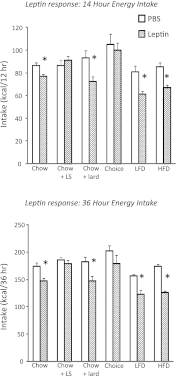Changes in glucose tolerance and leptin responsiveness of rats offered a choice of lard, sucrose, and chow
- PMID: 22496363
- PMCID: PMC3378343
- DOI: 10.1152/ajpregu.00477.2011
Changes in glucose tolerance and leptin responsiveness of rats offered a choice of lard, sucrose, and chow
Abstract
Rats offered chow, lard, and 30% sucrose solution (choice) rapidly become obese. We tested metabolic disturbances in rats offered choice, chow+lard, or chow+30% sucrose solution [chow+liquid sucrose (LS)] and compared them with rats fed a composite 60% kcal fat, 7% sucrose diet [high-fat diet (HFD)], or a 10% kcal fat, 35% sucrose diet [low-fat diet (LFD)]. Choice rats had the highest energy intake, but HFD rats gained the most weight. After 23 days carcass fat was the same for choice, HFD, chow+lard, and chow+LS groups. Glucose clearance was the same for all groups during an intraperitoneal glucose tolerance test (GTT) on day 12, but fasting insulin was increased in choice, LFD fed, and chow+LS rats. By contrast, only choice and chow+LS rats were resistant to an intraperitoneal injection of 2 mg leptin/kg on day 17. In experiment 2 choice rats were insulin insensitive during an intraperitoneal GTT, but this was corrected in an oral GTT due to GLP-1 release. UCP-1 protein was increased in brown fat and inguinal white fat in choice rats, and this was associated with a significant increase in energy expenditure of choice rats during the dark period whether expenditure was expressed on a per animal or a metabolic body size basis. The increase in expenditure obviously was not great enough to prevent development of obesity. Further studies are required to determine the mechanistic basis of the rapid onset of leptin resistance in choice rats and how consumption of sucrose solution drives this process.
Figures








References
-
- Ackerman Z, Oron-Herman M, Grozovski M, Rosenthal T, Pappo O, Link G, Sela BA. Fructose-induced fatty liver disease: hepatic effects of blood pressure and plasma triglyceride reduction. Hypertension 45: 1012–1018, 2005 - PubMed
-
- Alzamendi A, Giovambattista A, Raschia A, Madrid V, Gaillard RC, Rebolledo O, Gagliardino JJ, Spinedi E. Fructose-rich diet-induced abdominal adipose tissue endocrine dysfunction in normal male rats. Endocrine 35: 227–232, 2009 - PubMed
-
- Aplozan JW, Harris RBS. The effects of diet on consumption of scurose solution and lard and th development of obesity. Appetite 54: 631, 2010
-
- Axelsen LN, Lademann JB, Petersen JS, Holstein-Rathlou NH, Ploug T, Prats C, Pedersen HD, Kjolbye AL. Cardiac and metabolic changes in long-term high fructose-fat fed rats with severe obesity and extensive intramyocardial lipid accumulation. Am J Physiol Regul Integr Comp Physiol 298: R1560–R1570, 2010 - PubMed
Publication types
MeSH terms
Substances
Grants and funding
LinkOut - more resources
Full Text Sources
Medical

